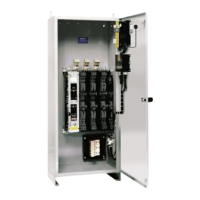Sequence of Operation
The information package supplied with the transfer
switch includes a schematic diagram and description
of operation of all accessories provided.
The sequence for load transfer to Source 2 begins
automatically when any phase of Source 1 falls below
the preset “fail” or dropout point and this undervoltage
failure condition is detected by the solid state phase
relays B1, B2, B3.
The phase relays drop out, de-energizing Source 1
control relay CR, and engine start timer P1 begins its
timing cycle. The P1 time delay is provided to override
momentar
y outages and to prevent nuisance starting
of the engine generator. If Source 1 voltage returns
above the “restore” or pickup setting of the phase
relays, the P1 timing cycle is reset to zero by the
re-energization of the CR relay.
If Source 1 voltage does not return before the P1 time
delay is completed, the P1 timer drops out and sends a
starting signal to the engine generator
. Source 2 voltage
and frequency sensing relay VFSM monitors the voltage
and frequency of Source 2. When both the voltage and
the frequency of Source 2 reach the preset “restore”
or pickup points, the VFSM relay initiates the transfer
to Source 2 and timer W begins its timing cycle.
The W timer provides an adjustable transfer delay
to Source 2 as required.
When the W time delay is completed, Source 2 control
relay R
T energizes and picks up the power relay, CE1 or
CCE. The power relay connects voltage from Source 2
to the Source 2 switch operating circuit causing the
switch to transfer its main contacts to Source 2.
The switch is mechanically locked in Source 2 position.
The power relay and Source 2 operator are de-ener
-
gized when the SE limit switch is activated by the
operator
. The SN limit switch is deactivated at the
same time, readying Source 1 control circuit for
retransfer when Source 1 is restored.
The sequence for retransfer to Source 1 begins automat-
ically when the voltage on all phases of Source 1 reach
the preset “restore” or pickup point and this condition
is detected by the solid state phase relays.
When Source 1 restores, the solid state phase relays B1,
B2, B3 pick up and initiate retransfer of the switch to
Source 1 by energizing timer T and beginning its timing
cycle. The T timer provides an adjustable delay to
ensure that Source 1 has stabilized before reconnection
to the load. If Source 1 fails before the T time delay is
completed, the phase relays drop out and the T timing
cycle is reset to zero.
When the T time delay is completed, Source 1 control
relay CR energizes and picks up the power relay
, CN1 or
CNN. The power relay connects voltage from Source 1
to Source 1 switch operating circuit causing the retransfer
of the main switch contacts to Source 1. The switch is
mechanically locked in Source 1. The power relay and
Source 1 operator are de-energized when the SN limit
switch is activated by the operator. The SN limit switch
also energizes the engine over-run timer U and begins
its timing cycle. The timer provides a period of time
for the engine generator to run without load and cool
down before shutdown. After the U time delay is
completed, the P1 timer is energized and the engine
generator is shutdown.
36
ZTS/ZTSD/ZTSH/ZTSDH/ZTSDL/ZTSHL/ZTSDHL Operation and Maintenance Manual (71R-3000)
GE Zenith Controls

